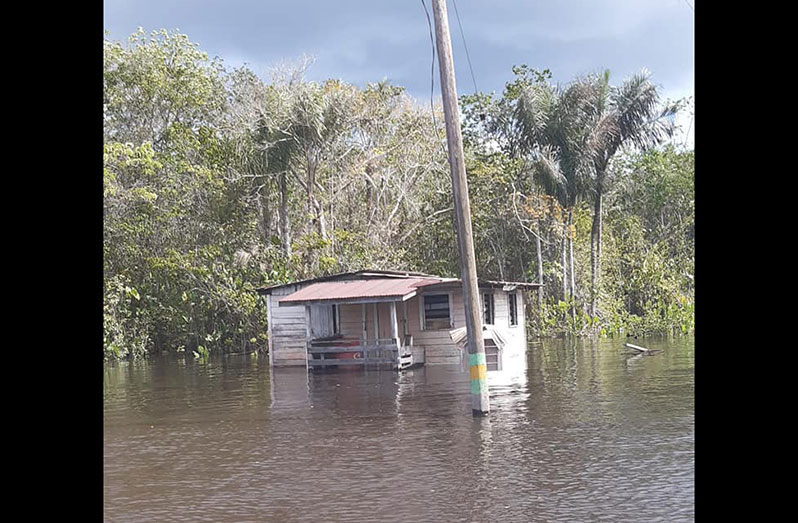ALTHOUGH the floodwaters at Kwakwani, Region 10, are slowly receding, residents are being urged once again to relocate to higher ground as the water level is likely to rise, given the heavy rainfall that is expected in the coming weeks.
Speaking with this newspaper on Sunday, Elroy Adolph, a resident of Kwakwani and councillor attached to the Region 10 Regional Democratic Council (RDC), explained that the waterfront and Lamp Island communities are located close to the Berbice River and several swamps.
Adolph emphasised that any amount of rainfall usually results in overtopping of the river and nearby swamps, which results in flooding in the two mentioned areas.
“The Kwakwani waterfront is like a dam. It has the river and then it has the swamps, so any rainfall would cause it to flood. When the river water rise and the swamp water rise, it covers the dam,” he added.
In May last year, the Regional 10 authorities declared Kwakwani to be in a “severe state,” since water levels had risen above 15 feet, completely covering several homes.
Yearly, when the May/June rainy season comes, residents would brace themselves for heavy torrential rainfall and light flooding. Efforts by residents to rebuild their lives following the 2020 flood, were recently disrupted after heavy rainfall led to severe flooding. This development has prompted the regional authorities to advise all persons living in flood-prone areas, such as Lamp Island and the waterfront, to relocate to higher ground.
Adolph disclosed that Jeep Landing has since been identified to facilitate relocation; however, many residents are still reluctant to make the move.
“I personally encourage many of them to go over there because it is higher ground and some have moved, about five or six of them have moved to higher ground and others are now thinking to clear spots and move, but if the water goes down, they will not move,” he said.
He noted that yearly, the authorities are faced with the challenge of convincing residents to relocate.

“Maybe if the whole place flood out for the whole year and they cannot do anything, then they would move. If the water recedes, they gone back to square one. So, it’s a bit of a challenge of what to do to really help them,” he said.
According to Adolph, the floodwaters of last year, have not completely receded and it is for this reason that it is critical for residents who live in vulnerable areas to relocate to higher ground.
“What you find is that we still had constant rainfall in between, so the swamps were still under water and so as soon as rain comes, it would just overflow. It’s like a cup, its actually full and so it’s just waiting for a little more to overflow.”
This newspaper was told that only four families out of the 46 that are in the danger zone have opted to move to higher ground.
SEASONAL FLOODING
To trace the history of seasonal flooding in the Region 10 community, this newspaper had spoken to the former Regional Chairman, Mortimer Mingo, who was the acting regional chairman some 10 years ago when severe flooding had hit the community.
Mingo, in that interview, had said that severe flooding in Kwakwani is a phenomenon that tends to occur every 10 years or so during the rainy season or whenever there is above-normal rainfall.
“There is what I want to call a cycle of flooding that takes place primarily in the Kwakwani Waterfront area. What happens is whenever there is persistent rainfall…the rain falls in the upper regions of the Berbice River so the water keeps rushing down there and it normally overflows the banks of the river in the vicinity of Lamp Island and also the waterfront area,” Mingo explained.
He noted that in 2006 just after a wave of severe flooding, the then government had identified an area in Kwakwani to be transformed into a housing scheme to facilitate the relocation of residents from the waterfront area. However, only a few residents would have opted to relocate to higher ground.
The Kwakwani Neighbourhood Democratic Council (KNDC) is currently working to establish flood shelters across the community. Previously, during periods of severe flooding, the NDC would utilise schools as shelters, but now that schools have reopened, alternative locations will have to be identified to house the affected residents.



.jpg)









